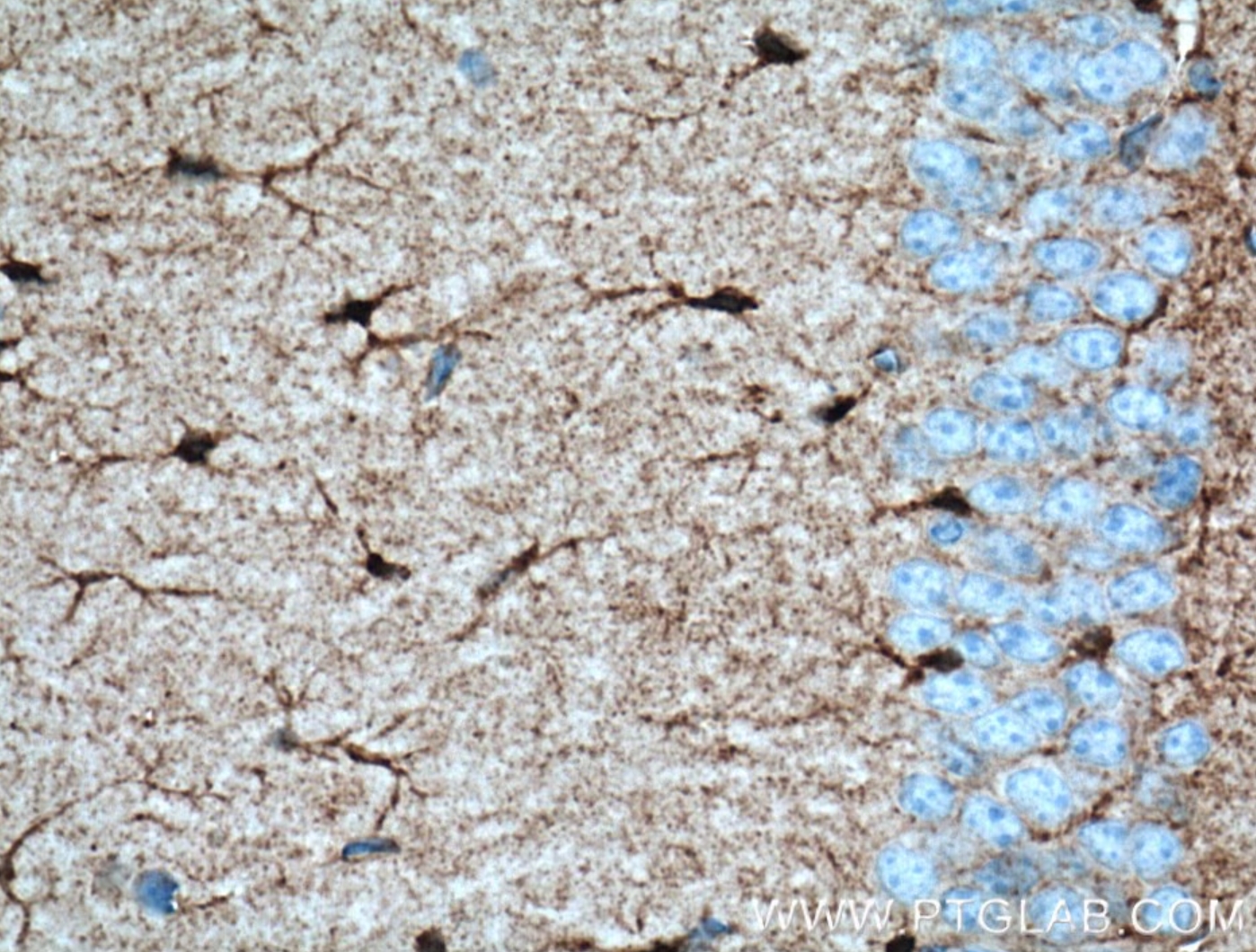小脳の免疫染色ガイド
Sophia Leung著(McGill大学、博士研究員)
はじめに
その名の通り「小さな脳」である小脳は、その細胞数が脳全体の約半数におよぶ一方で、脳の容積に占める割合はわずか20%程度に過ぎません。典型的には、協調運動において主軸となる役割を果たすと認識されています。しかし、近年の研究により、小脳は運動以外の認知機能にも関与することが明らかになってきました。その結果、自閉症スペクトラム障害に認められるような、小脳の神経発達や神経変性の病態変化に関する調査研究への関心が高まっています。
小脳皮質は、外側の分子層と内側の顆粒層からなり、その中間にプルキンエ細胞体が存在する、均一な層構造を示します。この層構造は予測が容易な規則性の高い組織配置をとります。そのため、組織学的解析は多くの有益な情報が得られる解析法の1つに挙げられ、樹状突起の分枝状態、分子発現パターン、細胞密度の異常といった小脳における病態変化の解明に有用な手法とされています。
プロテインテックは、小脳の特性解明に取り組む研究を支援するべく、様々な小脳細胞マーカーをターゲットとする抗体を幅広く取り揃えています。

図1. 小脳皮質の回路構成と細胞組成の模式図
神経細胞マーカー
カルビンジン(Calbindin)
カルビンジン(Calbindin)は、プルキンエ細胞を同定するための確立されたマーカーです。プルキンエ細胞は小脳に存在する主要な細胞で、小脳内外の数十万におよぶ細胞からの入力を受け取ってその信号を統合する、小脳皮質で唯一の出力ニューロンです。カルビンジンはカルシウム緩衝能を担い、プルキンエ細胞の高頻度発火に伴って生じるカルシウムイオン変動に迅速に対処するカルシウム結合タンパク質です。免疫組織化学(IHC:Immunohistochemistry)や免疫蛍光染色(IF:Immunofluorescence)等の手法でカルビンジンを染色すると、プルキンエ細胞の細胞体と、その極めて精緻な樹状突起を共に標識できます。
プロテインテックの標識カルビンジン抗体・非標識カルビンジン抗体は、様々なアプリケーションに対応し、ヒト、マウス、ラット、ブタ、ウサギ等の組織に適用可能です。

図2. Calbindin-D28k抗体(カタログ番号:14479-1-AP、希釈倍率1:1500)とAlexa Fluor® 594標識Donkey Anti-Rabbit IgG (H+L)抗体を使用した成体マウス小脳組織(4% PFA固定)の免疫蛍光染色解析像。
パルブアルブミン(Parvalbumin)
カルビンジンとは別のカルシウム結合タンパク質であるパルブアルブミン(Parvalbumin)は、小脳ニューロンの特定の細胞集団を識別する一般的なマーカーであり、免疫染色によりプルキンエ細胞亜集団と分子層介在ニューロンが検出されます。パルブアルブミン陽性のプルキンエ細胞は、特有のカルシウム恒常性と固有の発火特性を示し、疾患発症時には選択的に脆弱性を示す場合があります。パルブアルブミン陽性の分子層介在ニューロンは、さらにバスケット細胞と星状細胞に分類されます。パルブアルブミン抗体で染色すると、バスケット細胞と星状細胞の両方の細胞集団を可視化・観察できます。

図3. Parvalbumin抗体(カタログ番号:29312-1-AP、希釈倍率1:1500)とAlexa Fluor® 594標識Donkey Anti-Rabbit IgG (H+L)抗体を使用した成体マウス小脳組織(4% PFA固定)の免疫蛍光染色解析像。
カルレチニン(Calretinin)
カルレチニン(Calretinin)は、登上線維、顆粒細胞、顆粒細胞由来の平行線維の可視化によく利用される、小脳細胞に存在する第3のカルシウム結合タンパク質です。小脳の特定の領域においては、内顆粒層の単極刷子細胞(単極ブラシ細胞)の標識にも使用することができます。
プロテインテックのカルレチニン抗体はモノクローナル抗体・ポリクローナル抗体・組換え抗体を用途に応じて選択可能です。各抗体は幅広いアプリケーションに対応します。

F図4. Calretinin抗体(カタログ番号:82811-1-RR、希釈倍率1:500)とAlexa Fluor® 594標識Donkey Anti-Rabbit IgG (H+L)抗体を使用した、成体マウス小脳組織(4% PFA固定)の免疫蛍光染色解析像。
VGLUT1・VGLUT2
小胞型グルタミン酸トランスポーターであるVGLUT1とVGLUT2は、プルキンエ細胞とシナプス接続する平行線維終末と登上線維終末の一般的なマーカーとして使用されている神経伝達物質輸送体です。平行線維と登上線維は、プルキンエ細胞に対する主要な興奮性(グルタミン酸作動性)シナプス入力を担っています。平行線維の入力数は多いもののシナプス応答は微弱で振幅は小さく、登上線維の入力数は少ないながら大きな振幅を示します。プルキンエ細胞と接続する平行線維や登上線維のシナプスの存在量や空間分布を研究するために、平行線維はVGLUT1、登上線維はVGLUT2を免疫染色します。
プロテインテックの関連製品:VGLUT1関連製品
VGLUT2関連製品

図5. VGLUT1抗体(カタログ番号:55491-1-AP、希釈倍率1:200)とCoraLite® 488標識Goat Anti-Rabbit IgG (H+L)抗体を使用したマウス脳組織(4% PFA固定)の免疫蛍光染色解析像。
GAD67・GAD65・VGAT
小脳におけるバスケット細胞、星状細胞、ゴルジ細胞、深部小脳核のGABA作動性神経細胞を可視化する場合は、GAD67やGAD65といったマーカーが使用されます。GABA作動性細胞・グリシン作動性細胞のシナプス終末は、抑制性アミノ酸トランスポーターであるVGATを可視化して検出します。
プロテインテックの関連製品:GAD67関連製品
GAD65関連製品
VGAT関連製品

図6. GAD65抗体(カタログ番号:21760-1-AP、希釈倍率1:200)を使用したパラフィン包埋マウス脳組織の免疫組織化学染色。
Aldoc
プルキンエ細胞は、一見すると小脳全体にわたって均一な細胞集団であるにもかかわらず、その分子プロファイルに基づいて多くの亜集団に分類されます。Zebrin(Zebrin II)という名称でも知られるアルドラーゼC(Aldoc:Aldolase C)は、プルキンエ細胞の分類に幅広く使用されるマーカーです。Aldocの発現パターンは固有の発火特性や求心性神経支配と関連があり、Aldocの発現は機能的に重要な意義があると考えられます。

図7. Aldolase C抗体(カタログ番号:14884-1-AP、希釈倍率1:200)を使用したパラフィン包埋マウス脳組織の免疫組織化学染色。
グリア細胞マーカー
GFAP・S100B
バーグマングリア細胞は、プルキンエ細胞層にその細胞体が存在し、突起を伸展させてプルキンエ細胞シナプスを覆っています。GFAPは、バーグマングリア細胞の染色に一般的に使用されるマーカーです。ある種の疾患の中には、バーグマングリア細胞が過活動状態になり、高いレベルでS100Bを発現する病状を示すものがあり、活性化したバーグマングリア細胞を染色するためにS100Bが使用されます。

図8. IHCeasy GFAP Ready-To-Use IHC Kit(カタログ番号:KHC0002)を使用したパラフィン包埋ラット脳組織の免疫組織化学染色。
IBA1
ミクログリアは、形態、密度、分子プロファイルに関して領域依存的な不均一性を示し、小脳回路の発達に重要な役割を果たします。IBA1は、小脳のミクログリア細胞集団のマーカーとして使用されています。

図9. IBA1抗体(カタログ番号:81728-1-RR、希釈倍率1:500)とAlexa Fluor® 594標識AffiniPure Donkey Anti-Rabbit IgG (H+L)抗体を使用した成体マウス小脳組織(4% PFA固定)の免疫蛍光染色解析像。PBS buffer(pH 7.4)で熱処理し抗原賦活化した試料を使用。
EAAT1(GLAST)
グリア細胞は、細胞外空間からグルタミン酸を除去する働きによって、興奮毒性を防ぐうえで極めて重要な役割を果たします。小脳では、バーグマングリア細胞が興奮性アミノ酸トランスポーター1(EAAT1:Excitatory amino acid transporter 1、別名:GLAST)を介してグルタミン酸を除去するため、EAAT1はグルタミン酸取込み能の指標として、バーグマングリア細胞のマーカーに広く使用されています。

図10. GLAST抗体(カタログ番号:20785-1-AP、希釈倍率1:50)を使用したパラフィン包埋ラット脳組織の免疫組織化学染色。
新たな細胞特異的マーカーの発見
近年のシングルセルシーケンシング技術の進歩によって、発生の各段階にわたって小脳細胞を分子レベルで層別化できるようになったことが、新たな細胞型特異的マーカーの発見につながっています。新規小脳マーカーの需要の高まりに対応するべく、プロテインテックは今後も新製品を拡充していく予定です。
注目の小脳マーカー
|
細胞 |
特異マーカー |
カタログ番号 |
|
プルキンエ細胞 |
GLUD2 ITPKA |
|
|
分子層介在ニューロン |
Kcna2(バスケット細胞) |
|
|
顆粒細胞 |
ZIC1 |
参考文献


